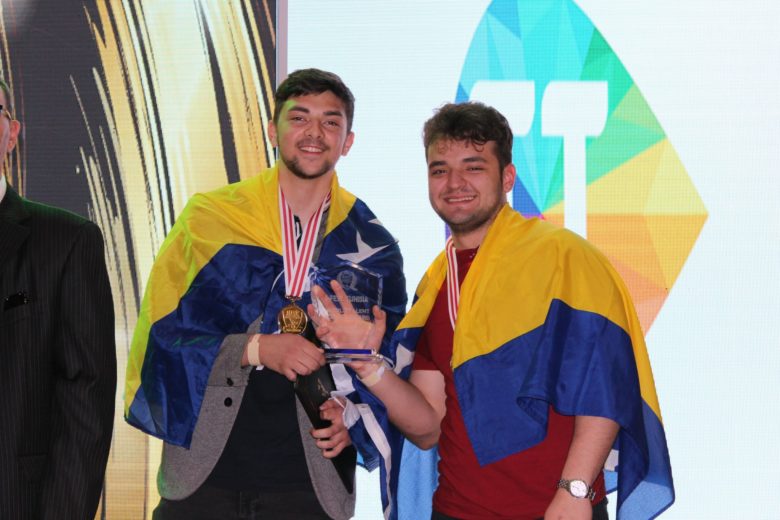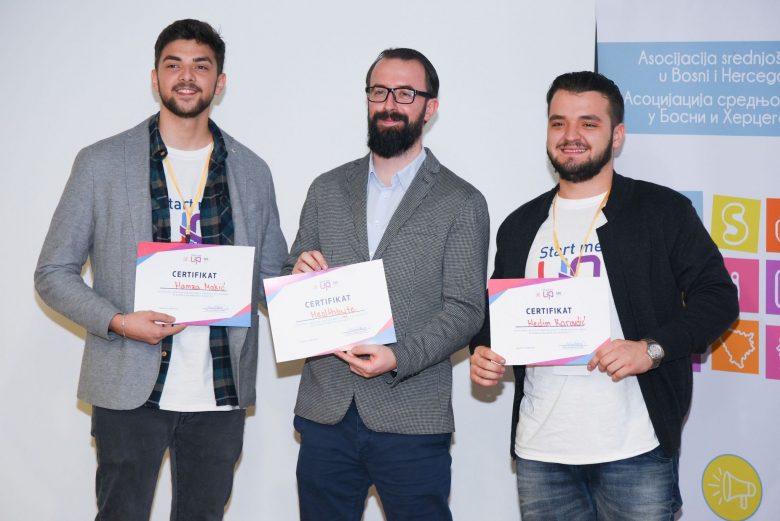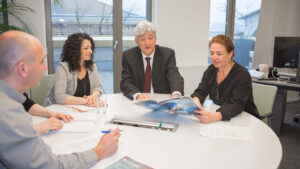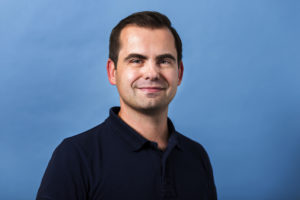Young Bosnian innovators create eye tracking system allowing disabled people to use computers

Тechnology makes life easier for all of us, including for people with disabilities, allowing them to live life to the fullest. In Bosnia and Herzegovina (BiH), a country where infrastructure, public services, and ITC technologies are largely inaccessible for this vulnerable group of our society, two young people have developed a system that would allow disabled people to use a computer with their eye movements.
The exact number of people with disabilities in BiH is not known as there is no single, comprehensive legal definition of a person with a disability that is applicable at all levels and in all legal contexts in the country, entities and cantons. The World Health Organization (WHO) estimates that they account for an average 15% of the population of any given country. Based on that estimation, there are more than half a million people with disabilities in BiH.
On a mission to help vulnerable members of society
Luminous, a system developed a year ago by Nedim Karavdić and Hamza Makić, aims to allow people with certain disabilities to use a computer with the help of their eye movements.
“While only a small number of disabled people in BiH would use such technology – and we don’t know exactly how many because there’s no national register of these people – computer accessibility would certainly make a world of difference to them,” said Binasa Goralja, BiH country co-ordinator of My Rights, an umbrella organization within the disability movement of BiH. “The government invests in aids that are medically prescribed, such as wheelchairs, but it does not invest in solutions that would help these people participate in life in every way,” she added.
Affordable solution
What sets Luminous apart from other eye-tracking systems is the price.
“Popular eye-trackers on the market cost tens of thousands US dollars, but the price of Luminous will be approximately $150. The manufacturing cost of our system is about $100. Price is the biggest problem we have been able to solve. What we need to do now is secure the funds necessary to place the product on the market,” Nedim Karavdić explained.
Almir Šahmanija, president of the Association of Persons with Muscular Dystrophy of the Canton of Sarajevo, is confident that an affordable eye-tracker would certainly be used on a regular basis by many people suffering from progressed forms of muscular dystrophy: “A couple of years ago, one lady in BiH got afflicted with Lou Gehrig’s disease that mostly affects people between the age of 45 and 55. Her husband bought her a computer with eye-tracking equipment for about EUR 6,000, and she was a really active user, both for work and for social networking. After she died, her husband sold it for approximately EUR 3,500. So, the existing assistive technology products for IT used by this category of people with disabilities are unaffordable.”
Hamza Makić says the team does not know of any other similar solutions in Southeast Europe that are already in use or under development. “There are companies that produce eye-tracking systems, but they do not fall into the same category as Luminous. The primary focus of Luminous is to be affordable and accessible to all users,” he said.
A year in the making
Luminous took Nedim Karavdić and Hamza Makić a year to develop. They developed it as high school students for high school competitions and it is now one of the projects of their Sarajevo-based startup Healthbyte.
Hamza Makić says that they had the opportunity to test Luminous at some startup pitches they took part in and they got a lot of useful feedback there.

“We would have liked to have had Luminous tested by more people with disabilities, but the opinions and ideas we got from talking to them were very positive and constructive.” Since Luminous currently consists of multiple tangible components that may be a bit uncomfortable to use, Nedim Karavdić says that the plan is to transform their project into a fully software solution. “This would enable people to buy the product with just a few clicks,” he added.
Challenges facing assistive technologies in BiH
Gradimir Kragić, an IT trainer for blind people, explains that the problem with BiH innovations in the field of assistive technology is that they can’t get past the initial stage: “We have no manufacturers of innovative aids and assistive technology products for people with disabilities in BiH. All such products are imported.”
Almir Šahmanija says that “potential users in BiH certainly come up with various innovative ideas, but since they’re not optimistic that they can be implemented here, they don’t bother with development. Development happens elsewhere.”
Fikret Zuko, ho heads the Association of the Visually Impaired People of the Canton of Sarajevo, explains that since BiH is a free-market economy, it’s not profitable for any company here to manufacture aids for people with disabilities because the number of end-users would be small.
“Assistive technology products are expensive because the companies that manufacture them have to do it on a small scale, so they raise the price to make it profitable for them. If the government would subsidize production, the companies would be able to sell their products at an affordable price. However, our state does not invest in such things, even though BiH has ratified the United Nations Convention on the Rights of Persons with Disabilities and all other international documents stipulating that the state is, in a way, obligated to provide such aids to these vulnerable people or to enable the provision of such aids under the most favorable conditions, and also to provide training in their use,” says Fikret Zuko.
An app for people in wheelchairs
Healthbyte is currently focused on the funding and development of their less demanding Wheel Fit project, a mobile fitness application intended for people with disabilities or people who are forced to spend a certain period of time in a wheelchair due to traffic accidents or similar incidents. Wheel Fit app provides users with a wide selection of exercises, training and nutrition plans, and fully adapts to the user because its recommendations are based on the user’s data (height, weight, age, gender and specific goal).
“Wheel Fit received a lot of suggestions and feedback from professional athletes and Paralympians. The plan is to improve the app by implementing this feedback, and then publish it on the Apple Store,” said Nedim Karavdić. Wheel Fit is already on the Google Play app store, and currently has 2,500+ downloads and 1,000 daily active users.
“We also have ideas for other projects that would be useful to people with disabilities, but they’re on hold due to the COVID-19 pandemic,” added Hamza Makić.
Technology with disabled people in mind
Gradimir Kragić and Fikret Zuko are confident that a GPS navigation app for the blind would enable people with disabilities in BiH to move more independently.
“There is a pretty good chance that such apps for mobile phones will become available in BiH because they’re affordable, they cost about EUR 10, although the users must be trained how to use them. On several occasions, I did localization of GPS navigation software that is used on iPhone or Android and intended for blind people, so I use it for free. To me, GPS is a very, very important thing that I use both in the place where I live and when traveling. I would not travel without a GPS,” explained Gradimir Kragić.
Suvad Zahirović, director of the Citizens’ Association Information Center for People with Disabilities Lotos in Tuzla, says that visually impaired and blind people would also benefit from the addition of a voice support option to products intended for general use, such as scales, medical devices and ATMs, as well as screens with enlarged text and more pronounced contrast.
“It is important to teach designers and researchers to take into account the needs of people who do not belong in the so-called ‘average’ consumer population. If they did, a large number of problems that disabled people face would be solved, and universally designed solutions would make products and services available to a much larger number of potential consumers. The good news is that a legal framework is being created at the EU level that would require manufacturers and service providers to make products and provide services in compliance with accessibility standards, and this would translate into the introduction of new technologies into general-purpose products and designing them in a way that would make them accessible to disabled people,” explained Suvad Zahirović.
“Examples of this new approach,” he said, “are ‘smart’ household appliances for everyday use, such as induction hobs that could speak instead of just beeping, washing machines that can be connected to smartphones, smart TVs with Android platform already come with built-in TalkBack or some other type of voice support, automation and the use of new technologies for household management, such as heating, air conditioning, opening and closing of windows and turning the lights on and off.”
Modern technology can overcome almost any type of disability, making it possible for this most marginalized group of our society to have more independence and fulfill their potential. The most important potential of assistive technology is lifting the disabled out of poverty by allowing them better access to education and employment opportunities. Instead of being a burden to society, they would be able to become taxpayers who contribute to society with their talents. As Suvad Zahirović says, “what is good for people with disabilities is good for everyone.”




























